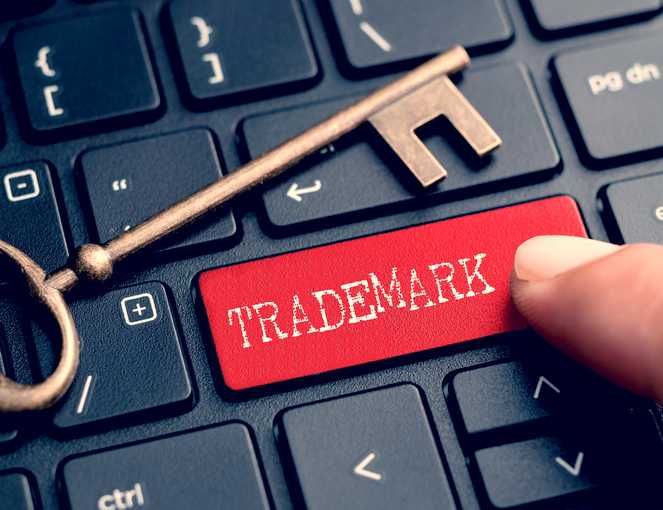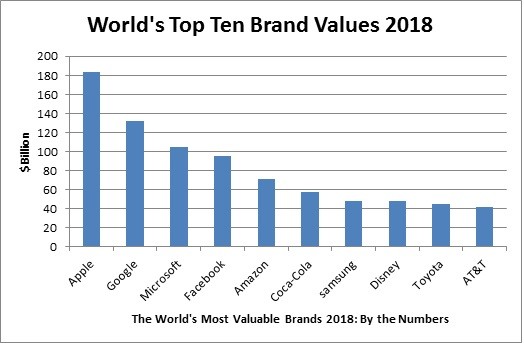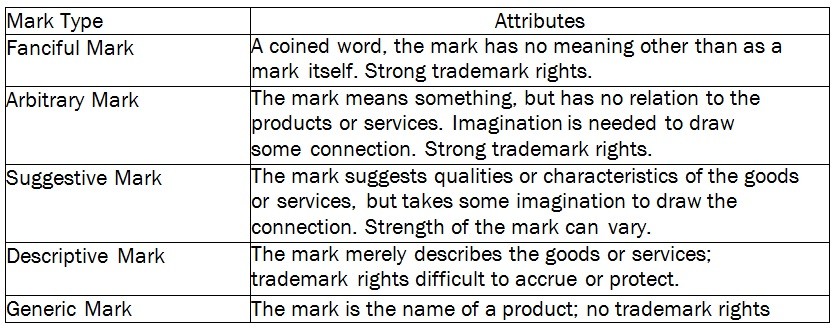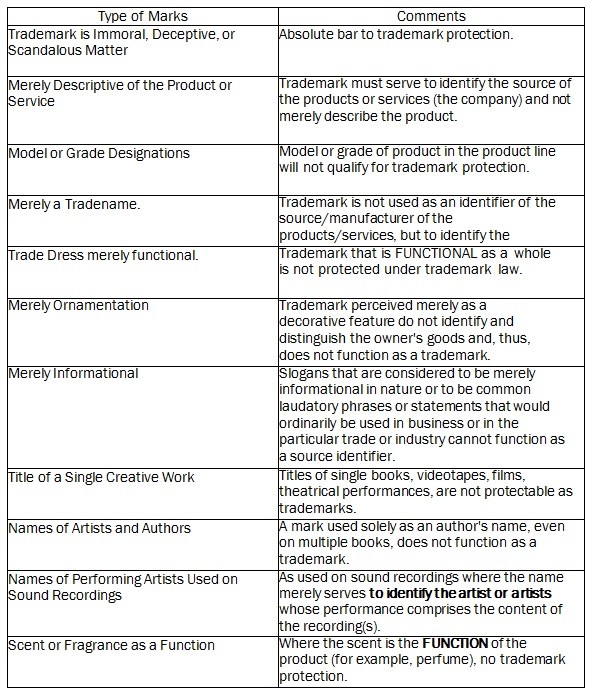Why Your Company Needs a Great Trademark
Why Your Company Needs a Great Trademark

A trademark is a powerful means to communicate a company’s brand identity to the public. When the use of the trademark, such as a symbol, word, name, logo and other device has the effect of creating a mental association between it and the company’s products and services, the symbol has acquired trademark significance and value for the company.
A distinctive trademark maximizes the effectiveness of the communication and greatly contributes to the value of the brand. Successful companies know this: They adopt strong trademarks as a symbol for their brands to create awareness as to what they can and will do over time for the public and to differentiate them from other competitors.
The chart below, derived from data collected by Forbes Magazine, illustrates how the world’s great companies are represented by their trademarks.
Table 1
Trademark Selection for Building Brand
Some trademarks receive stronger protection than others. A strong trademark is one that draws a mental connection between the brand owner and the public. The mental connection is created by a direct association between the trademark and the goods and services being offered. As a result, a strong trademark helps create brand loyalty and support for repeated businesses, which in turn helps drive long term, sustained growth and profitability. Very often this mental connection is a major component of the brand value, contributing to its owner’s competitive edge over its competitors. And, it is this connective attribute of the trademark that gives its owner the legal rights to prevent others from infringing on their mark.
To be protected, a trademark must be distinctive in that it must function as a source identifier of the commercial offerings. A strong trademark is clearly associated with the brand’s owner and not with any other persons or businesses. A strong trademark usually receives strong legal protection. In comparison, a weak mark receives limited protection.
The first step in selecting a strong trademark is to evaluate how distinctive the proposed trademark is. Table 2 below shows where the mark fits within the range from “fanciful” or “arbitrary,” to “merely descriptive,” “suggestive,” and “generic” and the relative strength of each type of mark receiving legal protection.
Table 2
A “fanciful” or “arbitrary” trademark is a word that has a common meaning, but is used as a trademark for a product that has no relationship to this common meaning. For example, the oft-cited example of “APPLE” is arbitrary as applied to computer equipment. A descriptive or generic trademark in one industry can be arbitrary and distinctive when used in another. While “APPLE” is an arbitrary mark for computer equipment, it is a generic or descriptive when the products are apples. Arbitrary marks are the easiest to acquire trademark significance, and serve as a means to identify the source of the products and services. But they require that the consuming public be educated about what the trademark represents.
Likewise, a fanciful mark, consisting of a coined word, carries no relationship to the products and services of the company. “KODAK,” “INTEL,” and “EXXON” bring to mind examples of fanciful marks. While good will surrounding these fanciful marks requires substantial years of promotion and investment, they attain trademark significance immediately upon use and are entitled to the strongest legal protection.
On the other side of the spectrum are the “descriptive” and “generic” trademarks.” A descriptive mark is one which when applied to the intended products and services leaves no imagination to the relevant purchasing public as to what the nature, quality, functions and ingredients of the products or services are all about. In that sense, “SWEET & SOUR” is clearly a descriptive mark for a sauce. So are “APPLE PIE,” descriptive of potpourri and “BED & BREAKFAST REGISTRY” for lodging reservations services.
Since it is only fair and indeed a matter of right that one should be able to accurately describe his or her products and services, the owner of a descriptive mark should not be able to obtain any protection, unless there is a likelihood of confusion caused by another party. While many businesses are inclined to choose a highly descriptive trademark because it is the easiest to market with the products or services that it describes, such use should be avoided as the legal protection of a weak, descriptive mark is minimal. And generic terms are not protectable at all.
Between the extremes of fanciful/arbitrary marks and descriptive/generic marks are suggestive trademarks. These are trademarks that suggest to the relevant purchasers what the trademark means without being purely informative as to the nature, characteristics or the functions of the products or services. While a descriptive mark leaves no imagination as to what the mark means, a suggestive mark usually would require some imagination, a cognitive connection or a pause in the mind of the purchasing public in order to connect the meaning of the mark with the products and services. Examples of suggestive marks include “STRIDE RITE” for shoes, “BASIC 4” for cereals and “KITCHENAID” for kitchen appliances.
In selecting a trademark to build brand value and to receive strong protection, the trademark owner should avoid those terms with the characteristics shown in Table 3 below.
Table 3
Avoid Confusingly Similar Trademarks
The selection of a trademark does not end with the question of whether the mark is fanciful, arbitrary, descriptive or suggestive. A trademark owner desires to distinguish the brand from those of others so customers can clearly remember the owner of the trademark and what it represents. The trademark should be unique so consumers have no other ideas about the mark other than it being a symbol representing one unique owner. This is where a trademark clearance search can help to avoid other similar trademarks in the market place.
A little effort and expense upfront to assess whether there are other similar or potentially conflicting trademarks and to evaluate the extent to which the trademark can be protected by trademark registration can help avoid potential litigation later on.
The United States Patent and Trademark Office (“USPTO”) has a web site that contains a database of registered and abandoned U.S. trademarks, as well as pending trademark applications. However, the USPTO database does not include common law usage which could otherwise establish superior prior rights based on another company’s unregistered use alone. Trademark rights arise out of the use of the mark in connection with the products and services that a business markets and sells. The day that a company first used the trademark (common law usage) was the day that it began to acquire common law trademark rights. Since the USPTO database does not include such common law usage, it is advisable that a full search be conducted.
Of course, as a practical limitation, the full search cannot be expected to exhaust coverage of all possible situations of uses in the stream of commerce. But a full search does offer much more information than a search of the USPTO records and therefor provides a much higher level of confidence in assessing the availability and registrability of a proposed trademark. In some cases, a full search is considered a necessary part of a corporate executive’s due diligence in the selection and use of trademarks.
The evaluation of a proposed trademark for its availability and registrability requires legal analysis. Just because there is no identically spelled trademark out there does not mean that there are no confusingly similar marks (in spelling, pronunciation and commercial meaning as applied to the products and services and the marketing environments) to give rise to a potential conflict. Is “TRUCOOL” for synthetic coolant likely to be confused with “TURCOOL” for cutting oil? How about “CITY WOMAN” and “CITY GIRL,” both for clothing? Or “BEST JEWELRY and design” for retail jewelry and “JEWELERS BEST” for jewelry?
When referring to an identical or a similar trademark, it is meant in a legal sense. Since a prior user of a trademark has the exclusive right to prevent others from using a confusingly similar trademark on similar or related products or services, to reduce the potential for trademark conflict, the evaluation of a mark would need to go beyond the mere spelling of the mark, and is best left to a trademark attorney.
Conclusion
Brand values are keyed to the success and failure of many businesses. A strong trademark is at the heart of a successful brand. Creating, building and growing a brand is a continued and challenging process. A strategy in selecting a distinctive and distinguishable trademark and achieving the proper protection for enforcement is the added value that an experience trademark attorney can contribute.
MEDIA CONTACT
Patrick Ross, Senior Manager of Marketing & Communications
EmailP: 619.906.5740
EVENTS CONTACT
Suzie Jayyusi, Events Planner
EmailP: 619.525.3818




